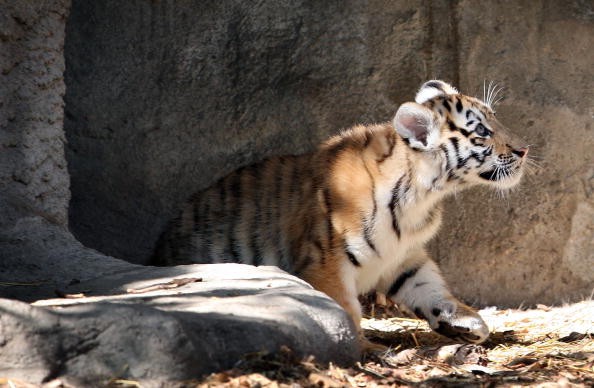Sino-Russian Nature Reseve to Protect Amur Leopards to be a Reality Soon
| Garima Vohra | | Aug 19, 2015 07:08 PM EDT |
(Photo : Photo by Scott Olson/Getty Images) (Photo by Scott Olson/Getty Images) The population of Amur leopard in China and Russia is believed to be increasing.
A joint operation this year by the researchers from China and Russia has reported a rise in the population of Amur leopard in both the nations.
The Amur leopard is also known as the Far East Leopard, Manchurian Leopard and Korean Leopard. The International Union for Conservation of Nature categorizes this animal as an endangered species.
Like Us on Facebook
The recently released report says abount 80 Amur leopards are living in Hunchun, Wangqing and Laoyeling nature reserves of China and some Far East regions in Russia - good news for the conservationists worldwide.
In early 2015, a census conducted by the World Wildlife Fund (WWF) revealed that the population of Amur leopard has more than doubled in seven years. The number of the big cat in Russia's Land of the Leopard National Park was at least 57 and in the border areas of China eight to 12 leopards were counted.
Another survey conducted in 2007 had put the number of Amur leopard at 30 in Russia.
For a long time, several wild life conservation groups from around the globe have been pushing for the establishment of a Sino-Russian nature reserve to promote the free migration of the big cats across the borders between the two countries. This would also encourage greater genetic diversity and dispersal of young adult leopards.
The two countries recently signed a cooperation deal to establish a cross-border monitoring network for both Amur leopards and Siberian tigers.
"There is still a lot of work to be done in order to secure a safe future for the Amur leopard, but these numbers demonstrate that things are moving in the right direction," said Dr. Barney Long, Director of Species Conservation for WWF-US.
At one point, Amur leopards were scattered throughout northeastern China, including Jilin and Heilongjiang Provinces (the name Manchurian leopard is derived from here), and the Korean Peninsula. The percentage of Amur leopard in Russia decreased in the seventies.
The researchers agree that the population of Amur leopard and Siberian tigers is on a rise and reflects the efforts being made by various agencies to protect them.
"The efforts are to be applauded but lot of work needs to be done for safeguarding the habitat - sufficient space and enough prey for keeping the rising numbers of Amur leopard secure needs to be considered," said Ge Jianping from Beijing Normal University.
Since agriculture and villages surround the forests where leopards live, poaching is one of the biggest threats. The Amur leopard is known to favor roe deer, sika deer and hare over other animals for pre. The deer is also hunted by the villagers for food and money.
For instance, in the Russian Far East, deers are raised for food and to produce antlers for the Asian medicine market. This leads to conflict between big cats and humans, hence the killing.
TagsSino-Russian Border, amur leopard, World Wildlife Fund, Russian Leopard Park, Russian Far East, Manchurian Leopard, Nature Reserves Of China, International Union for Conservation of Nature
©2015 Chinatopix All rights reserved. Do not reproduce without permission
EDITOR'S PICKS
-

Did the Trump administration just announce plans for a trade war with ‘hostile’ China and Russia?
-

US Senate passes Taiwan travel bill slammed by China
-

As Yan Sihong’s family grieves, here are other Chinese students who went missing abroad. Some have never been found
-

Beijing blasts Western critics who ‘smear China’ with the term sharp power
-

China Envoy Seeks to Defuse Tensions With U.S. as a Trade War Brews
-

Singapore's Deputy PM Provides Bitcoin Vote of Confidence Amid China's Blanket Bans
-

China warns investors over risks in overseas virtual currency trading
-

Chinese government most trustworthy: survey
-

Kashima Antlers On Course For Back-To-Back Titles
MOST POPULAR
LATEST NEWS
Zhou Yongkang: China's Former Security Chief Sentenced to Life in Prison

China's former Chief of the Ministry of Public Security, Zhou Yongkang, has been given a life sentence after he was found guilty of abusing his office, bribery and deliberately ... Full Article
TRENDING STORY

China Pork Prices Expected to Stabilize As The Supplies Recover

Elephone P9000 Smartphone is now on Sale on Amazon India

There's a Big Chance Cliffhangers Won't Still Be Resolved When Grey's Anatomy Season 13 Returns

Supreme Court Ruled on Samsung vs Apple Dispute for Patent Infringement

Microsoft Surface Pro 5 Rumors and Release Date: What is the Latest?










